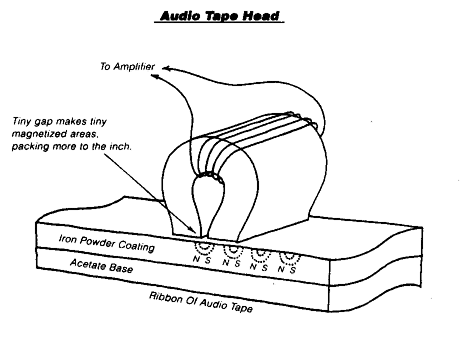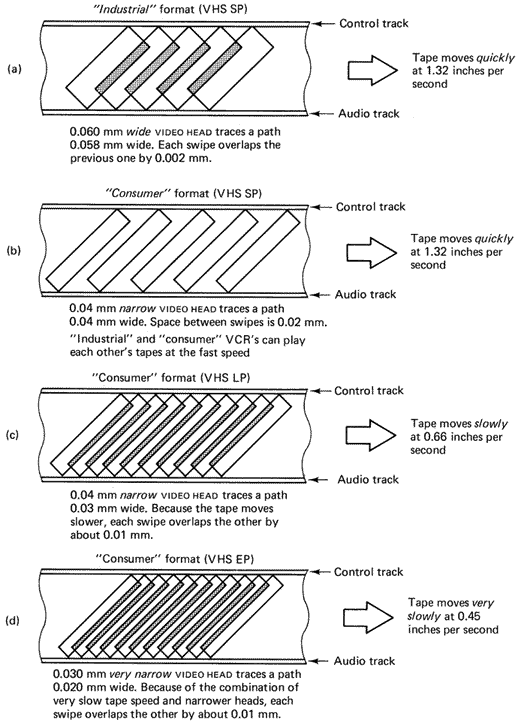

211
Don't run away. I promise not to snow
you with
techno-babble. This is just a simple explanation of how your
camcorder stores pictures and sound on tape.
--Recording with electromagnetism
Someday, when you have nothing productive to do, wrap some
insulated wire around a nail and attach the wire ends to a small
battery. The nail will suddenly become magnetized (unless the
battery is dead). You have created an electromagnet.
Incidentally, don't try this with a car battery or something with
high voltage --- you'll end up making a hot plate, or maybe a
light bulb (without the bulb).
Put a compass near your electromagnet and you will find
that one end of the nail registers north and the other, south.
Reverse the battery and the magnetic poles reverse (the compass
will line up in the opposite direction). If you put an
alternating current through the wire (current that oscillates
from positive to negative), your magnetic field will oscillate
north to south. Every electrical oscillation will create a
magnetic oscillation. (I once knew a girl whose osculations also
had a magnetic attraction, but that's another science
altogether.)
Remove the battery from the wires and connect in its place,
a sensitive meter, and then wave a magnet near your coil. You'll
discover that the passing magnetism will be converted into
electricity. You'll have created a generator much like Michael
Faraday invented in 1831.
If you bring a magnet, even an electromagnet, near iron or
some other magnetizable material, it will become magnetized.
This is the science Vladimar Poulsen, a Danish engineer, used
in
the late 1800's when he invented the first magnetic recorder.
In Poulsen's device, sound was converted into electricity
which activated an electromagnetic recording head. A steel wire
passing over the head on its way from one reel to another would
become magnetized by the head. Thus electrical vibrations were
converted to a long string of magnetized areas. Later, the wire
could be "played" by passing it over the head which
sensed the
weak magnetic variations and generated corresponding electrical
vibrations.
In the early 1900's the invention of vacuum tubes made
amplifiers possible. Thus, your voice could vibrate a diaphragm
in a microphone where it wiggled a magnet near a coil of wire
that created a weak electrical signal. The signal would be sent
to an amplifier, an electronic valve that can transform weak
electrical signals into strong ones. The strong electrical
vibrations magnetized the tape head during recording. During
playback, the head converted weak magnetic vibrations into weak
electrical signals that were amplified and sent to a speaker.
--Packing in the good vibrations
Wire recorders had poor fidelity and were used pimarily for
dictation. During World War II the Germans improved the fidelity
of the tape recorder by impregnating paper, and later plastic
tape with iron particles. This made it possible to configure the
recording head with a tiny gap over which the tape would slide.
Because of the area of magnetism was confined and small, a
magnetic "wave" could be recorded in a tiny space, allowing
thousands of waves to be recorded in an inch of tape. This is
how today's reel-to-reel tape recorders, audiocassette decks,
and
even digital compact cassette decks record their signals. In
VCRs that don't have hi fi, the signals are recorded this same
way along the edge of your video tape. The little stripes where
the audio is recorded are called linear audio tracks.

Hi fidelity sound ranges in frequency from
20 to 20,000
vibrations per second. It isn't easy to pack 20,000 magnetic
vibrations into an inch of tape. Professional recorders simply
move the tape faster so that each vibration gets more space.
Recent technology has squeezed the record head gap smaller so
that each magnetic vibration would be smaller. There is a limit
to how small you can go before one magnetic vibration interferes
with its neighbor, in effect, erasing it. In fact, that's how
tape recorders and camcorders erase tape: they send very high
frequency vibrations to an "erase head" upstream from
the record
head. The erase head remagnetises the tape, essentially undoing
the old magnetic vibrations, and because the new vibrations are
so close together, they even erase each other, leaving no sound.
Here's another way to picture this concept. If you printed
a sign with big letters, you could only put a few words on the
sign. If you were trying to get more words on a page, you could
print the letters closer together, but eventually they would
overlap and become hard to read. In fact you could move the
letters so close together that they merged into one big black
blob on the sign, totally undecipherable. You could put more
words on the sign if you printed the letters smaller, analogous
to what the tiny gap on the record/play head does. Note that
even tiny lettering becomes undecipherable if you print thousands
of letters almost on top of each other, again obliterating your
sign into a black blob, again similar to erasing a tape.
The bigger the letters are on a page, the easier they are
to read, but the more space they take up. In tape recording, the
same happens: Professional audio tape recorders use big "fat"
heads that imprint broad, robust magnetic waves on the tape.
Home audio equipment, on the other hand, uses tiny heads making
tiny magnetic vibrations, like fine print on the sign. But like
the fine print, the tiny vibrations are hard to "read".
They
create weak electrical signals fraught with hiss and other noise.
Also, for high fidelity, you need to move the tape quickly.
Just as you didn't want the overlapping letters on your sign to
obliterate each other, you don't want the magnetic regions on
the
tape to overlap, erasing each other. Thus we meet one of the
laws of engineering vs. marketing: Hi fi sound takes up lots of
space (lots of tape, lots of bucks). Lo fi sound is more compact
and cheaper.
This is why professional VCRs (betacam, digital) have high tape
speeds. This also
explains why recordings you make at your fastest tape speed look
better than recordings made at slower speeds. The audio fidelity
from the linear tracks also is better at a high tape speed
(SP-standard play).
--Video recording similar to audio
While the highest audible sound frequency is 20,000
vibrations per second (Hertz, abbreviated Hz), television signals
require several million vibrations per second. This is because
every dot that makes up your picture on your TV screen represents
an electrical vibration. One TV picture lasting 1/30 of a second
may consist of 1/4 million such dots, all repeated 30 times in
1
second. After electronically discarding some less important
details, we end up with a video signal of 4 to 5 million Hz.
The first audio/video recorder was patented by Ritcheouloff
in 1927, but it took nearly 25 years before a working model could
be developed. It was essentially a souped up audio recorder
running at 200 inches per second. Needless to say, the TV
programs needed to be short. And imagine the camcorder you would
have to carry.
Now imagine what would happen if you moved the tape slowly
and moved the tape head quickly, placing it on a spinning drum
so
that it made hundreds of diagonal swipes across the tape every
second. This is what Ampex did in 1956 when it introduced "Quad"
(short for quadrature, because four heads were on a spinning
drum) video tape recorder. In 1961, JVC simplified the mechanism
by wrapping the tape around the spinning head drum in a technique
called "helical scan", the method we use today. Advances
in
technology have allowed the head gap to get smaller, the track
widths (the magnetic "road" recorded by the head) to
become
skinnier, and the head to spin faster, improvements designed to
pack more vibrations into a smaller and smaller space.
--Anatomy of a video recording
As I mentioned before, linear audio is recorded along one
edge of the tape. The video is recorded by a spinning drum which
creates diagonal tracks across the tape.
Along the opposite edge of the tape is the control track,
sort of magnetic "sprocket holes" that guide the machine
during
playback. Here's how they work: When the VCR is recording,
every time the video head takes a swipe across the tape, the
control head (another stationary head, like the audio head)
places a pulse at the edge of the tape. When the tape is played
back, the spinning video heads are supposed to follow the
magnetic paths made by the recording heads. If they get off a
little and start playing the space between the tracks, you
experience mistracking, a band of hash or snow across the
picture. The control pulses tell the video heads when to swipe
across the tape so that they stay centered in the recorded paths.
Mistracking is a common problem among VHS and SVHS VCRs.
Anything that causes the spinning video heads to wander off their
magnetic highways (which is only about 15 millionths of an inch
wide) causes havoc. Stretched tape, damp playing conditions
(causing the tape to act "sticky" and not slide smoothly
through
the mechanism) minor mechanical or electrical misadjustments,
all
conspire to lead your video playback heads down the wrong path.
Dirt buildup on the control head confuses the machine altogether;
it's like driving with your windshield covered with mud --- you
won't stay on the road for long.
--Hooray for fat heads
Industrial and consumer VCRs and four-headed VCRs when they
use their slow or fast speeds, use different width video heads
yielding different picture qualities.
Try this analogy: When a VCR makes its recording, it's
like paving a multi-lane highway. Industrial VCRs with "fat"
heads working at the fast tape speed will pave wide roads. Such
tapes play back nicely on both industrial and home VCRs. An
industrial VCR with fat playback heads is like a wide car on the
wide road. If it wanders off the road a little ways, it is still
mostly on the road, picking up a good signal. Home VCRs with
skinny heads are like narrow cars going down the wide road. It
is easy for them to stay within the recorded area. When
professionals duplicate tapes, they use industrial VCRs with fat
heads. The resulting tapes play well in most VCRs, even slightly
misadjusted ones. This also explains to some degree why the
copies professionals make, look better than the tape copies you
can make.

Consumer two-headed VCRs record narrow
roads, leaving less
room for error. It is easy for a car to wander off the road
(tracking error). Furthermore, the narrow road contains less
information (causes a grainier picture). At the two hour mode
(SP) your home VCR leaves some space between the tracks, like
a
grassy median strip between roads. Thus when a tape head wanders
off the road on an SP recording, it's playing some of the quiet,
unrecorded area on the tape (the grassy median strip with no
interfering traffic). This doesn't look too bad.
If you record at the slow speed (EP), you lose the median
strip and the lanes are so close together that they overlap a
little. Now there is very little room for error. In fact, you
are making a little error when you are driving carefully in the
middle of your lane. EP recordings (which are always made with
skinny heads) are always troublesome. When you share an EP
recording with a friend, their tape machine "drives"
a little
different the one that originally paved the road, and a lot of
lane wandering occurs (graininess and tracking problems).
--Hi fi audio, the new ballgame
Remember how non hi fi VCRs recorded audio? as a linear
stripe along the edge of the video tape. When stereo VCRs came
out, the stripe was divided into two half-size stripes (like a
dual lane highway where a single lane highway used to exist).
One magnetic track would play through the left channel and the
other through the right channel for stereo.
Nonprofessional machines require you to record both tracks
at the same time. Pro models allow you to record one track and
then another, perhaps overdubbing to add narration or music to
something already recorded on the tape.
Because the linear tracks are separate from the video
tracks, they can be separately edited or dubbed. Conversely, the
video can be erased and replaced without touching the old audio.
Slow moving video tape was never a prize-winning way to
record audio. It was hard to pack so many vibrations onto a tape
traveling about one inch per second. Then came hi fi audio. If
an audio head were placed on the spinning drum along with the
video heads, then the audio head would be moving fast enough to
record high frequencies, thus hi fidelity. The problem is how
do
you get the spinning audio head to "listen" only to
the audio
while the video head "listens" to the video, all embedded
into
the same track? There are various ways to do this, but VHS and
SVHS VCRs use "depth multiplexing". Here the video heads
record
high video frequencies on the surface of the tape while the audio
heads record relatively lower audio frequencies deeper into the
tape. Each head is optimized to "listen" to its specific
frequencies and tunes out the other in much the same way a
husband tunes out a wife's conversation while he's watching a
ballgame on TV.
When a recording is made, the audio head first records the
hi fi signal to a depth of 4 microns (millionths of a meter),
then the video head comes along and records its signal on top
of
it .7 microns deep. Although the video erases the topmost layer
of the hi fi audio signal, there is enough remaining from the
deeper layer to provide good sound. All of this explains why you
cannot erase hi fi audio without erasing the video and vice
versa. If you remagnetize the deep audio particles of the tape,
you would also be erasing the video particles at the surface.
Thus the only way to edit your sound or your picture in the VHS
and SVHS formats is to abandon the hi fi tracks and use the
linear audio tracks.
Incidentally, VCRs automatically record both the linear and
hi fi audio tracks simultaneously while you make your initial
recording. Editing your audio will only change your linear audio
tracks. Editing your video will change the video tracks and the
hi fi audio tracks but will still leave the linear audio tracks
untouched. VHS and SVHS hi fi tracks are stereo.
Hi 8 and 8mm VCRs work differently. Hi fi sound is
recorded as part of the picture, inseparable from it, much like
VHS and SVHS. The recording technique called AFM (Audio
Frequency Modulation) is slightly different from VHS, but the
result is the same. Hi fi AFM sound is monaural, not stereo,
however.
Although the 8mm format calls for a linear audio track, it
is not used in today's VCRs. Instead another technique called
PCM (Pulse Code Modulation) is used to record audio with the
video head but separate from the video. How do they do this?
The video head takes a swipe across the tape. When it reaches
near the bottom, it stops recording video and starts recording
digital audio using the same head. Thus, one swipe of the head
does two jobs. During playback, the head listens for video
sending it to the screen and when it reaches the end of a swipe,
shifts its attention to audio sending the digits to a circuit
that converts the signal back into stereo sound. Because the PCM
audio is not recorded beneath the video magnetism, it can be
separately erased and edited (on "pro" camcorders and
Hi 8
editors). Similarly, the video can be separately edited; all you
lose is the AFM audio track. This feature makes editing hi fi
sound in the 8mm format easier and more flexible than in the VHS
format.
Enough science. Your heads must be full by now.
I have skipped some details for brevity and am guilty of a
few oversimplifications here. The engineers among you don't need
to send me shame-on-you-email enlightening me about subcarriers
and frequency modulation, etc. I'll save those stories for
bedtime --- they'll surely put us all to sleep.
| About the author | About Today's Video 4th. ed. | Return home |